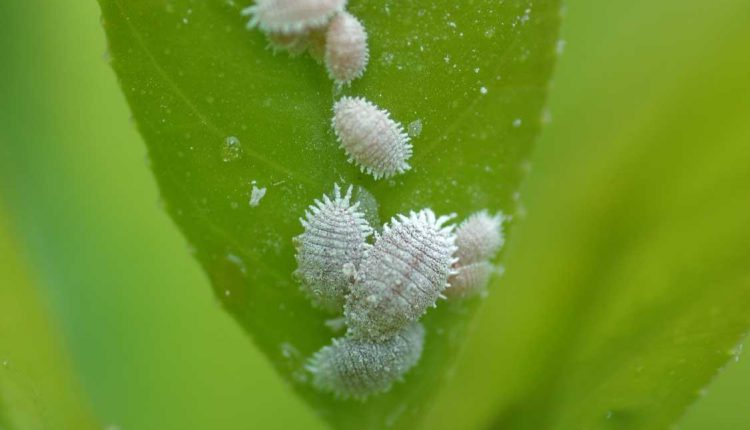They may look like little fluffy cotton balls with legs, but the damage mealybugs can do on houseplants and in the outdoor garden is serious. Mealybugs, a cousin to other garden pests like scale and whiteflies, can damage many flowering and ornamental plants by direct feeding and by introducing diseases into the garden. Organic gardeners can control this pest in several ways without resorting to toxic pesticides.
Identify mealybugs and mealybug damage
Mealybugs are tiny insects, about 1/8 inch in length, but their color and clustering habit make mealybugs easy to find on garden plants. Most common mealybug species are white, and have waxy looking filaments covering their bodies, giving them a fuzzy or hairy appearance. An exception is the hibiscus mealybug, which is pinkish-brown and lacks the fringe.
What plants to mealybugs like to feed on? Many of our favorite houseplants are susceptible to mealybug infestations, including gardenias, jade plants, ficus trees, English ivy, hoya, and palms. In the outdoor garden, watch for mealybugs on coleus, begonias, Gerbera daisies, marigolds, and chrysanthemums. Any plant that has experienced high nitrogen levels from over-fertilization will be especially appealing to the pests.
Mealybugs feed on garden plants by inserting their sharp mouthparts into the leaves and stems to suck sap. Damaged leaves look wrinkled or puckered, and the insects can contaminate cut flowers with webby egg sacs and clusters of larvae. The honeydew mealybugs excrete compounds the damage, as it harbors black sooty mold and encourages the growth of plant viruses.
Deal with small mealybug outbreaks
You can manage small mealybug infestations with a simple blast of water. Use a plain jet of water to disrupt the bugs’ feeding, and spray plants with neem oil to discourage the bugs from coming back. Neem oil spray will not affect bees, making it ideal for the pollinator-friendly landscape.
Integrated pest management for mealybugs
Several species of parasitic wasps prey on mealybugs, so flower gardeners should attract these predators with nectar rich plantings of yarrow, sweet alyssum, and bee balm. Lacewings and pirate bugs also feed on mealybugs, so gardeners should be aware of the possibility of damaging these pests with insect spray, even if the spray is organic.
The honeydew mealybugs exude attracts ants, which aren’t pests themselves, but protect mealybugs from natural predators. Planting common vetch as a cover crop can draw ants away from mealybugs by providing a supplemental nectar source. Gardeners can also discourage ant colonies by tilling the surface of the soil to disrupt nests.
Biological pest control for mealybugs
Organic gardeners have at least two commercial options for biological mealybug control. The ladybug species Cryptolaemus montrouzieri, commonly called the mealybug destroyer, feeds voraciously on mealybugs at all stages of development. In fact, gardeners must take care not to mistake this beneficial insect for a pest, as the larvae of this ladybug resemble mealybugs. Gardeners can order adult mealybug destroyers to release during periods of high infestation, and this ladybug will feed on other garden pests like aphids or thrips when the mealybugs are gone.
Gardeners can use the OMRI (Organic Materials Review Institute) approved insect-killing fungus marketed under the trade name Mycotrol, which contains spores of Beauveria bassiana. Gardeners can use this product until the day of harvest for cut flowers, as it’s safe for people, animals, and the environment.
Organic sprays for mealybugs
As soft bodied insect pests, mealybugs are susceptible to insect soap sprays. Gardeners must spray mealybugs directly with the insect soap to disrupt the cell membrane and kill the insects, so this spray doesn’t work as a preventative agent. Insect soap is a short-acting spray, and you must reapply weekly for as long as the pests are active. The biggest drawback of insect soaps is their potential to damage or burn plants. To reduce plant toxicity, spray plants in the evening and spray them with water in the morning, as high temperatures and sunlight increase plant damage from insect soap.
Mealybugs on houseplants
Mealybugs and their nymphs thrive in greenhouses, making this insect pest common on houseplants. Orchids are particularly susceptible to damage and death from mealybug infestations. Isolate new houseplants for one week before placing them around other houseplants. Inspect the plants each day for signs of white mealybugs or their webbing, and kill any insects with a cotton swab dipped in rubbing alcohol.
Головні новини Seeds та агроідеї для зростання вашого бізнесу в Telegram Facebook Instagram
Youtube та Підписуйтесь!



